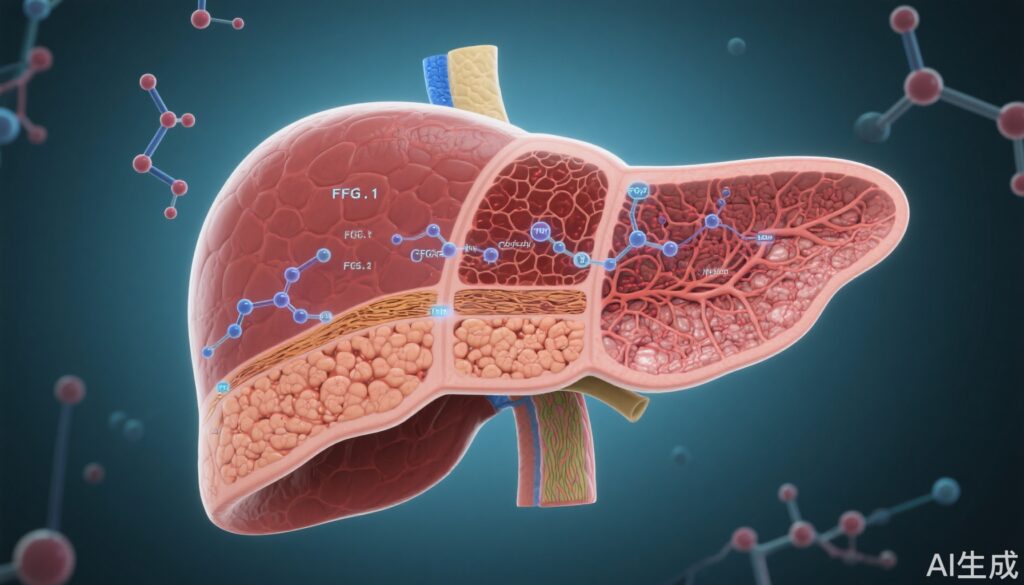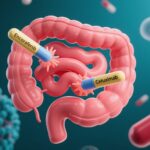Highlights
- Efruxifermin, an FGF21 analogue, did not significantly reduce fibrosis at 36 weeks in patients with compensated cirrhosis due to MASH.
- At 96 weeks, greater proportions of patients on efruxifermin showed fibrosis improvement compared to placebo, suggesting a delayed but potentially meaningful effect.
- Gastrointestinal side effects were more frequent in the treatment arms but mainly mild to moderate in severity.
- The results inform ongoing development of medical therapies for advanced metabolic-associated liver disease.
Clinical Background and Disease Burden
Metabolic dysfunction–associated steatohepatitis (MASH), formerly known as NASH, represents a major cause of chronic liver disease worldwide and is highly associated with obesity, diabetes, and metabolic syndrome. Disease progression leads to liver fibrosis and, ultimately, cirrhosis—a stage marked by architectural distortion, portal hypertension, and risk of liver-related morbidity and mortality. Currently, no pharmacological agent is approved for the treatment of advanced fibrosis or cirrhosis due to MASH. Liver transplantation remains the only definitive therapy for end-stage disease, underscoring a critical unmet need for effective, disease-modifying drugs, especially for patients with compensated cirrhosis (stage 4 fibrosis), who retain synthetic function and may respond to antifibrotic interventions.
Research Methodology
This phase 2b, randomized, placebo-controlled, double-blind trial (SYMMETRY; NCT05039450) evaluated the efficacy and safety of efruxifermin—a bivalent fibroblast growth factor 21 (FGF21) analogue—in adults with biopsy-confirmed compensated cirrhosis (stage 4 fibrosis) due to MASH. Patients were randomized to receive either weekly subcutaneous efruxifermin (28 mg or 50 mg) or placebo. The primary endpoint was the proportion achieving at least a one-stage reduction in fibrosis without worsening of MASH at 36 weeks. Secondary endpoints included the same measure at 96 weeks. Liver biopsy at baseline and follow-up provided objective, histological assessment of fibrosis and disease activity.
Key Findings
Of the 181 randomized patients, liver biopsy data were available for 154 at 36 weeks and 134 at 96 weeks. At 36 weeks, the primary endpoint was achieved by:
– 13% (8/61) in the placebo group
– 18% (10/57) in the 28-mg efruxifermin group (adjusted difference: 3 percentage points; 95% CI, –11 to 17; P=0.62)
– 19% (12/63) in the 50-mg efruxifermin group (adjusted difference: 4 percentage points; 95% CI, –10 to 18; P=0.52)
At 96 weeks, results were:
– 11% (7/61) in the placebo group
– 21% (12/57) in the 28-mg efruxifermin group (difference: 10 percentage points; 95% CI, –4 to 24)
– 29% (18/63) in the 50-mg group (difference: 16 percentage points; 95% CI, 2 to 30)
Although the primary endpoint at 36 weeks was not met with statistical significance, numerically more patients in the efruxifermin groups showed improvement at 96 weeks, especially at the higher dose, suggesting a potential delayed therapeutic effect. Importantly, the confidence intervals at 96 weeks for the 50-mg group excluded zero, indicating a statistically significant difference versus placebo.
Gastrointestinal adverse events (e.g., diarrhea, nausea) were more common with efruxifermin but were generally mild or moderate. No new or unexpected safety signals emerged.
Mechanistic Insights
FGF21 analogues like efruxifermin are hypothesized to improve hepatic steatosis, inflammation, and fibrosis by modulating lipid metabolism, glycemic control, and anti-inflammatory pathways. Preclinical and earlier-phase clinical data have shown promising antifibrotic effects, particularly in earlier stages (stage 2 or 3 fibrosis) of MASH. The current study extends investigation into stage 4, where the fibrotic milieu and cirrhotic architecture may limit reversibility.
Expert Commentary
While efruxifermin failed to reach the primary endpoint at 36 weeks, the 96-week data suggest longer treatment durations may be required to discern meaningful histological improvements in compensated cirrhosis. As cited by opinion leaders in hepatology, slow turnover of fibrotic tissue and the resilience of cirrhotic architecture may necessitate extended therapy to observe benefit. The signal for efficacy at higher dose and longer duration is encouraging, but must be validated in larger, longer-term phase 3 trials.
Controversies or Limitations
Key limitations include the relatively modest sample size and incomplete biopsy follow-up (attrition from 181 to 134 patients at 96 weeks), which may affect statistical power and generalizability. The use of histological outcomes, while rigorous, is subject to sampling variability. Moreover, the trial was not powered to detect differences in clinical endpoints such as decompensation, transplant-free survival, or liver-related mortality. The increased rate of gastrointestinal adverse events may impact tolerability in clinical practice.
Conclusion
Efruxifermin did not significantly improve fibrosis at 36 weeks in compensated cirrhosis due to MASH, but longer-term data at 96 weeks indicate a possible delayed benefit, particularly at higher doses. These results suggest that antifibrotic strategies may require extended administration and earlier intervention for maximal impact. Further phase 3 studies are needed to clarify the clinical utility of FGF21 analogues for advanced MASH.
References
1. Noureddin M, Rinella ME, Chalasani NP, et al. Efruxifermin in Compensated Liver Cirrhosis Caused by MASH. N Engl J Med. 2025 Jun 26;392(24):2413-2424. doi: 10.1056/NEJMoa2502242.
2. Sanyal AJ, Friedman SL, McCullough AJ, Dimick-Santos L. Challenges and opportunities in drug and biomarker development for nonalcoholic steatohepatitis: Findings and recommendations from an American Association for the Study of Liver Diseases–U.S. Food and Drug Administration Joint Workshop. Hepatology. 2015 Nov;62(5):1496-1505.
3. Younossi ZM, Loomba R, Rinella ME, et al. Current and future therapeutic regimens for nonalcoholic fatty liver disease and nonalcoholic steatohepatitis. Hepatology. 2018;68(1):361-371.


